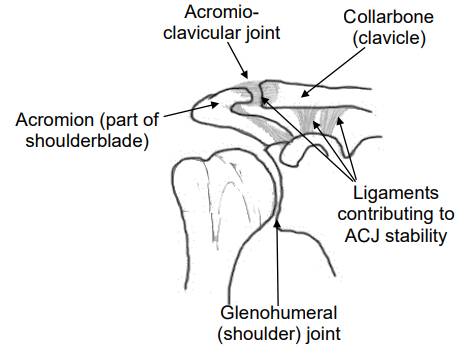Acromioclavicular joint (ACJ) injury
Please note, this page is printable by selecting the normal print options on your computer.
Description of Injury
The acromio-clavicular joint (ACJ) is where the collarbone meets the shoulder blade. Injuries here are most commonly caused by a fall onto or direct blow to the shoulder. The force causes an injury to the ligaments that surround and stabilise the ACJ.
Injuries vary in their severity from a sprain of the joint that does not result in any abnormality on XRays, to those where ligaments are fully torn. Typically symptoms include localised pain, swelling and visible deformity.

Treatment Protocol
The majority of patient with ACJ injuries may be treated non-operatively. This consists of local measures such a sling and ice packs and regular pain relief. Progressive gentle mobilisation is recommended, with a gradual return to activities as symptoms allow.
In specific cases early surgery may be considered. This is indicated in very displaced dislocations, or those that displace in an unusual direction. These are rare circumstances usually caused by high energy trauma. If surgery is advised then your surgeon will discuss this with you in more detail.
Recovery Expected
Most patients find that they are able to start weaning themselves out of the sling within a few days, and to have a graded return to function over a few weeks. Symptoms can take 4-6 weeks to settle
and any visible deformity will be permanent.
Exercises to aid recovery
Your doctor may give you specific exercises or refer you to physiotherapy. However broadly you should try to keep the shoulder supple and initially concentrate on movement exercises within the pain free range. As the pain settles, load bearing exercises can be introduced.
Expected Return to function (work/sport)
Return to sport or manual work is possible once the pain has settled and shoulder movements have returned to normal. This may take 4-6 weeks to achieve.
Possible complications
In rare cases there may be ongoing pain, or recurrence of pain. Further clinical review should be sought especially if pain and function is still impaired at 3-6 months post injury:
• Those with significant deformity and ongoing pain may benefit from a ligament reconstruction procedure. This surgery works well even if done long after the initial injury.
• Those who develop arthritis in the ACJ may require pain relief, injections or in some cases an operation to remove the damaged joint.
Where to go for more help / information
If you have any further questions or concerns please contact your GP or the fracture clinic (Monday-Friday 9am-5pm) on 01908 995205.
